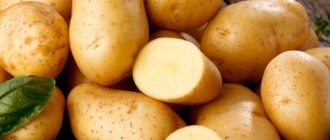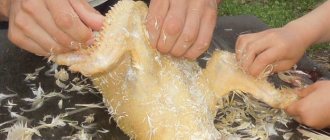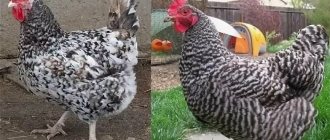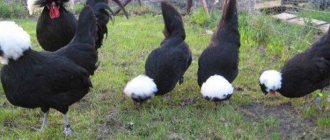Chicken slaughter begins with the preparation of the bird and ends with its processing. This whole process requires compliance with a number of rules, otherwise the output can be of poor quality meat, for example, due to putrefactive processes occurring in the intestines. How to prepare and slaughter a chicken, and then remove its feathers and cut up the carcass, we will find out further.
Poultry selection and preparation for slaughter
First, you need to select the birds intended for slaughter. An experienced farmer can determine by eye which chicken is suitable for slaughter, but beginners should proceed from the weight of the bird - it should be at least 2-2.5 kg. Suitable specimens must be caught from the herd and transferred to a separate room a day before slaughter. They must be maintained according to the following rules:
- Approximately 24 hours before slaughter, feed chickens with wheat bran or rye flour (about 25% of the main feed). Then transfer the chickens to artificial starvation. It should be noted that some farmers use another method to speed up digestion in poultry - 24 hours before fasting they give a 2% solution of Glauber's salt.
- Before slaughter, chickens should not be fed for about 18 hours to cleanse their intestines and stomach.
- Give chickens fluid in the required amount, as it helps cleanse the digestive tract, digest leftover feed and retain water in the muscles. In addition, if birds are not allowed to drink, this will lead to a loss of their overall body weight.
To further speed up the digestive processes of chickens, some farmers turn off the lights the night before slaughter. In the dark, their body becomes disoriented, which leads to faster digestion of food debris. In this case, the drinking bowls must be full.
Raising chickens for meat
Keeping chickens of meat breeds differs from breeding birds of the egg and mixed type. They require special conditions and a diet that promotes rapid weight gain. It is advisable to select early maturing breeds and crosses for quick fattening and obtaining products with high taste. The older the chicken, the worse the taste of the chicken. The ideal options for breeding are broiler crosses and early-ripening representatives of the meat and meat-egg production.
Raising chickens for meat
The most popular breeds and crosses for meat production are described in the table.
| Name | Fattening time | Specifics of nutrition and maintenance | Advantages | Flaws |
| COBB-500 | Reach a weight of 2.3-2.7 kg by 40-45 days. | Standard scheme for feeding broilers. Hypersensitivity to changes in air temperature and slow growth rate of plumage are taken into account. | Rapid growth, profitability, commercial and taste qualities of meat products, unpretentiousness. | Frequent illnesses and high demands on feed quality. |
| ROSS-308 | The minimum fattening time is 6 weeks. During this period, chickens reach 2.1-2.5 kg. | Traditional technology. Enhanced hygiene care is required in the first weeks and regular use of antibiotics to prevent disease. | Record growth rate, low cost of meat products combined with high taste. | High mortality rate up to 7 days. Weak immunity. |
| Change | Fattening requires 40-45 days. This time is enough to raise chickens to 2.25-2.5 kg. | It is necessary to organize a stable air temperature of 30-32 degrees in the first days of keeping, reduce it slowly and gradually. Protect the flock from drafts and dampness. Feeding and care do not differ from the standard. | Low feed costs, strong immunity, high survival rate (95-96%). | Hypersensitivity to cold, drafts and high humidity. |
| Gibro-6 | 6-8 weeks for fattening chickens to 2-2.1 kg of live weight. | Unpretentious, resilient and omnivorous birds that do not require specific care. | Low feed consumption (up to 3.5-3.7 kg per 2 kg of body weight), omnivorousness, low mortality rate (up to 3%). | Relatively low meat productivity. |
| ROSS-708 | The record growth rate is up to 2.7-2.9 kg in 45-48 days. | The use of protein feed with a percentage higher than 25% is required. | High rate of weight gain, readiness for slaughter in 35-40 days, unpretentiousness. | High feed consumption, increased requirements for their quality. |
For lovers of exotic breeds of meat-class chickens with unusual taste qualities, there are special breeds. Faverolles, La Flèche are French laying hens whose meat tastes like game. Silki, Kadaknath, Ayam Tsemani are exotic chickens with black meat and bones that taste like rabbit meat.
Basic rules for keeping and raising broilers that every poultry farmer should know:
- chickens are sorted by sex during the first week - roosters and hens are fed separately. A three-stage feeding system is followed: starting, growing and finishing rations;
- disease prevention measures are applied. An optimal microclimate is created (air temperature corresponding to age, humidity 55-60%);
- a fenced, spacious range is being built for poultry activity, which improves the taste of the meat;
- a comfortable poultry house with deep bedding for floor maintenance is being installed;
- It is possible to raise broilers in cages, but this increases the percentage of fat in the meat carcass.
For each individual species, proper feeding organization is required. The diet is followed - 3-4 meals daily during the fattening period. Feed for raising chickens for meat must contain at least 20% proteins, as well as a full range of mineral compounds and vitamins.
Important! A common myth that can cause mass mortality is that broilers need hormonal drugs to grow. In fact, rapid weight gain is genetically determined and no supplement can affect this - you shouldn’t risk the flock by introducing hormonal drugs!
Requirements for the place of slaughter
It is necessary to prepare the place for slaughtering poultry in advance. It must strictly comply with sanitary and hygienic standards. To do this you will need:
- wash tables, walls and floors using 2% bleach;
- treat the instruments by boiling them for about 15 minutes;
- disinfect the pen removal machine;
- wash the overalls in which the slaughter will be carried out (apron and robe).
Cleaning of the premises must be carried out before and after slaughter.
Experienced farmers equip the place where poultry is slaughtered with the following items:
- hooks that attach to the wall so that chickens can be hung on them;
- table;
- large saucepan;
- slaughter cone;
- bucket or basin;
- plastic bag or cloth;
- tools (axe, sharp knives, forks for gutting);
- a refrigerator with a freezer and a smokehouse to store meat later.
It is also worth preparing a lot of water in advance to rinse the processed carcasses, as well as clean the dishes, tools, tables and walls. In addition, you will need warm water (about 90°C) to scald the bird before plucking, if necessary.
Methods of slaughter
There are several techniques for slaughtering chicken, the choice of which should be made depending on how long you plan to store the meat in the future. So, if it will not sit for a long time before cooking, poultry farmers recommend using a fairly simple method - removing the bird’s head with a cleaver (axe). If meat is subject to long-term storage, slaughter should be carried out externally. Let’s look at what each technique is separately.
Removing the head
The most popular method involves removing the chicken's head using a cleaver (axe). As a rule, the chicken dies immediately, so this method can be considered quite humane. The procedure is simple, so every farmer can handle it. So, you need to do the following:
- Place the bird on a stump and hold it tightly so that it does not escape. If you do not have the necessary experience, you can initially resort to the help of another person who will hold the bird.
- Swing and hit the cleaver in the middle of the neck. To avoid torturing the bird, it is very important to cut off its head the first time.
- A bird, even without a head, can begin to struggle and convulse. At this moment it is important not to let her out of your hands.
- Once the head is cut off, hang the chicken by its legs on a hook and place a bucket to collect the blood.
This technique allows you to cut the airways and cause instant death of the bird, so it does not have time to feel pain. However, this method also has a negative side - chicken meat cannot be stored for a long time, since microbes penetrate into the open cuts in the neck and lead to rapid spoilage.
Internal method (“into the cleft”)
It involves the rapid removal of blood, so that the resulting meat can be of high quality with excellent presentation. The essence of the method is to slaughter birds through a hawse, which is implemented according to the following instructions:
- Stun the bird with a strong blow to the head using a blunt, heavy object. This procedure is mandatory in the case of slaughtering large breed chickens. If you need to kill a small bird, then it is not necessary to stun it, although this can be done for humane reasons.
- With your left hand, grab the bird’s head, and then turn its beak towards you, that is, in the direction from which you plan to slaughter.
- With a sharp movement of your right hand, insert a narrow, long and well-sharpened knife into the chicken’s beak, with which you need to break the connection of two veins - the jugular and the pavement. The cut can be made using scissors that have sharpened ends.
- Pull the instrument towards you and make an injection to the right and slightly lower, so as to enter the anterior part of the cerebellum through the palatine fissure. Thanks to such simple manipulations, it will be possible to relax the muscles of the bird, speed up the bleeding of the carcass and make it easier to pluck the feathers, since they will not stick tightly to the skin.
- Hang the bird upside down and place a basin to drain the remaining blood.
- After bleeding, insert a cloth or cotton swab into the beak to absorb any remaining blood.
The internal slaughter method is also not used in cases where it is planned to obtain meat for long-term storage.
External method
Many farmers more often use the external method, especially when slaughtering large chickens, including broiler breeds. At the end, it is possible to obtain marketable meat that is subject to long-term storage. The fact is that with the external slaughter method, only small cuts are made, so microbes actually do not penetrate inside the bird and do not infect the meat.
It should be noted that the external slaughter of chicken can be one-sided or two-sided. Each method has its own nuances, so two instructions should be considered.
One-sided slaughter using the external method is performed in the following order:
- Grab the bird's neck with your left hand, closer to the head.
- Take a sharp knife in your right hand and make a cut 1.5-2 cm long. The optimal place for the cut is 2 cm below the left earlobe. It is necessary to insert the knife deeper to reach and cut the blood flow paths - jugular (venous) and arterial (facial and carotid).
The two-way method is carried out according to the following instructions:
- With your left hand, grasp the bird's neck.
- Take a knife or scissors in your right hand and pierce the skin of the chicken at a point that is 1 cm below the earlobe.
- Point the blade to the right side to immediately cut through 2 carotid arteries and jugular veins. It turns out that the knife should go right through. In order to perform the necessary manipulations in one motion, the blade must be perfectly sharpened. The optimal incision size is up to 1.5 cm.
Regardless of the method of external slaughter, after it is carried out the workplace will not be stained with blood, since there are no bloody splashes.
Cone application
At home, you can use a special cone-shaped device made of metal to slaughter poultry. You need to hang it, and then put the chicken's head through the bottom hole. This device secures the bird well, so it does not beat its wings and is not injured. You can place a bucket underneath, into which the blood will drain after slaughter. Slaughter can be done using scissors or a knife using one of the technologies presented above.
What a cone for slaughtering a bird is can be clearly seen in the following video:
Boneless cutting
When it is necessary to prepare minced meat, meat rolls, semi-finished products from pulp, the ability to separate meat from bones comes to the rescue
It is important not only to be able to cut meat, but also to maintain the attractive appearance of the pieces. It is best to remove bones from the entire carcass without damaging the skin.
Farmers who supply chicken products to restaurants may face such a request. Such skill is appreciated and considered a plus for the seller. For boneless cutting, use the sharpest possible knife. The process provides two cutting options: open and closed.
Public method
For the open method of separating meat from the bone, follow this scheme:
The skin is incised vertically along the entire back. It is acceptable to start with the breast, but this may cause damage to the carcass. The bones in the back are located very close to the skin and can tear it if pressed. Using a knife, carefully remove the meat from the skeleton, moving from the tail from bottom to top. The ischium, wing and hip joints are broken to expose the ribs. Use your hands to help move the pulp. Free the femur completely by trimming the veins in a circular motion. Move the meat with your fingers
Carefully scrape the flesh down to the outermost cartilage, maintaining the connection between the thigh and body. Having reached the bottom point, cut off the upper joint
Turn the resulting “stocking” inside out and repeat the same on the other side. Trim the ribs using scissors. Get rid of the keel and fork bones by trimming the remaining joints. Leave the wings on the carcass along with the bones or cut them off from the skin. The process is over.
Private method
In order to use the closed method of boneless cutting of a carcass, follow these recommendations:
Through the lower hole in the carcass, through which the bird is gutted, cut the tail and expose the ischial frame. The incision is made in jerky movements, moving up to the upper femoral cartilage. For convenience, it is permissible to slightly tuck the skin and pulp during the process.
Next, use a blade to carefully cut the joint at the junction. The veins are trimmed along the entire circumference of the ham
Where the knee touches the shin, a fracture of the joint is made. The same machinations are carried out on the second side of the carcass. Then you need to trim the meat from the ribs to the neck, still tucking in the skin with the flesh already separated. The neck is sharply pulled out with hands. The breast fillet is cut off from the body and the wing joints are broken off. The fork-shaped bone must be removed, and the flesh of the drumstick must be cleaned around the circumference, cutting the ligaments. The bones are cut off in front of the cartilage, the skeleton is removed and the skin and meat are turned out.
Cutting a chicken so that it looks presentable, does not lose its attractiveness, and has no bones is difficult, but doable. How to do this is shown in the video:
Poultry plucking methods
After slaughtering the bird and bleeding the carcass, you will need to quickly and efficiently pluck the feathers. The fact is that this procedure will become much more complicated if the carcass cools down. Plucking can be done manually or using a special device.
Manual methods
There are several methods of manually removing chicken feathers:
- After the blood has drained, place the carcass on a plate and begin palpating. In this case, you need to move in the following sequence - tail, wings, back and chest, neck and legs. In order not to spoil the skin, it is necessary to pluck a small number of feathers.
- After slaughter, place the chicken carcass in a bucket of boiling water for 30-40 seconds, then transfer it to a basin and begin palpating. It is not recommended to keep it in boiling water for longer than the specified time, as the skin can cook, so plucking will become much more difficult. Remove feathers and down in the same order as for cold plucking. To make it easier to remove feathers, it is recommended to pull them out in the direction of growth. This method is advisable to use when slaughtering chicken intended for laying eggs. She is usually old in age, so the feathers hold on tightly.
This type of palpation will produce an unpleasant odor, so the procedure should be carried out outdoors and not indoors.
- Place the bloodless carcass in hot water for 30 seconds, and then transfer it to a plastic bag for 15 minutes, closing off air access to it. It turns out to be a steam bath, thanks to which the skin is well steamed. After this, you need to remove the feathers in the previously specified order. With this method, the time for plucking birds is significantly reduced.
- After the blood has drained, wrap the chicken in cloth. Bring a steam iron to it and turn on the steam function. Steam the chicken carcass. The pores on her skin will expand so the feathers can be easily removed.
The listed methods are acceptable when it is necessary to process no more than 2-3 birds, since each chicken takes about 30 minutes. For mass slaughter, the mechanical method should be used.
Mechanical method
It is carried out using a special device in the form of a rotating brush with silicone bristles. It is necessary to bring the carcass to it, which should be smoothly turned as the lint fingers pull out the fluff during rotation.
The palpation procedure takes little time, but there is one drawback - mechanical removal of feathers can sometimes damage the skin. If the bird is not offered for sale, this will not cause concern. If the carcass is being prepared for sale, then you must act extremely carefully so as not to spoil its presentation.
Methods for slaughtering chickens at home
In homestead farming, external and internal (“splitting”) methods of slaughter are used. When using the first method, which is the easiest to perform, better bleeding of all types of birds is ensured.
Using the second method allows you to quickly separate the feathers when slaughtering chickens.
- When carrying out the external method of slaughtering a bird , it is necessary to hang it by its legs and lay its wings on top of each other. Then they take the chicken by the head, stretch the neck and cut the carotid artery with a sharp knife.
- During internal slaughter, scissors with a sharp blade are inserted into the bird's mouth, with which the jugular vein (above the tongue at the back of the palate) is cut. Next, an injection is made with scissors into the palatine fissure towards the back of the skull. After the destruction of the cerebellum, the bird's muscles weaken, which has a beneficial effect on cleaning the feathers.
Rice.
1. Methods of slaughtering chickens: external (left) and internal (right): 1 - palatine fissure, into which an injection is made during slaughter, 2 - place of cut of the vessels, 3 - pontine vein, 4 - jugular vein, and - slaughter through the mouth, b - places of incisions of blood vessels during slaughter. How to kill a chicken externally and internally is shown in Figure 1. Then the bird is left hanging upside down for better bleeding.
Note: Insufficiently drained blood affects poor storage, since the liquid remaining in the body is a good breeding ground for various microbes. The type and age of the bird influences the choice of slaughter method and time for bleeding (can vary within 1-2 minutes).
Immediately after bleeding is completed, plucking begins, and feathers can be separated using the dry method, as well as by pre-treatment in hot water. The temperature for processing should not be higher than 53 C, and the chicken carcass should be kept in water for no longer than two minutes.
There is also a way to slaughter chickens without using a knife. In this case, bleeding and cutting are carried out immediately after slaughter.
How to kill a chicken in this way is shown in Figure 2:
- Take the bird's paws in your left hand. With your right hand, grab the chicken by the neck and pinch the head between your index and middle fingers.
- Pull your head back and down a little. This will quickly break your cervical vertebrae.
- After this, immediately tie the bird’s legs, hang it and begin plucking, first removing the feathers on the wings, then on the legs, and finally from the body.
Rice.
2. Slaughtering a chicken without using a knife Before slaughtering, the bird should not be fed for 24 hours. This will cleanse her digestive tract and the meat will be of higher quality.
Removing remaining droppings and scorching
This procedure is called “carcass toilet.” To do this, press on the bird’s belly and at the same time change the paper swab in the mouth so that it absorbs the last blood clots. If excrement gets on the chicken's legs, they should be washed with water without touching the body itself.
After toileting, it is necessary to singe the carcass to remove the thin plumage. In this case, you can use a gas burner. If you don’t have one at hand, then singeing can be done over a fire, but you should first rub the carcass with flour, as it will help quickly get rid of the soot on the bird’s skin. When all the fluff has been removed, the chicken must be washed. After this it will turn pink.
Carcass processing
After all the feathers have been removed, you need to start gutting the carcass. Such a complicated procedure is performed according to the following instructions:
- Cool the chicken carcass in cold water for 10 minutes. Otherwise, the capillaries will fill with blood, so the carcass will take on a dark, unpleasant hue.
- Place the bird belly up.
- Make a circular incision in the cloaca, and then a large longitudinal incision, which in adult birds and young birds is usually 4 cm.
- Remove the giblets, starting with the removal of the intestines with the cloaca. Be very careful when removing the gallbladder, otherwise it may be damaged. In this case, the bile will spread throughout the carcass, and the meat will have to be thrown away, as it will taste bitter.
- From all the removed entrails, save the liver, heart and stomach. In this case, you will need to carefully and without tearing separate the stomach from the end of the duodenum. It is recommended to throw away the remaining entrails or give them to pets.
- Rinse the heart and liver and use it to prepare various dishes. Cut the stomach in half with a sharp knife, remove stones and pieces of glass, and then rinse, scald with boiling water and remove the top layer. Only after these manipulations can it be used in cooking.
- Make an incision in the neck from which the trachea and esophagus are removed. Also make a small hole near the larynx through which to remove the crop.
- After removing the internal organs, rinse the carcass thoroughly and wipe dry.
After processing, it is worth allowing the meat to “ripen”. To do this, it must lie at room temperature for several hours. If you cook it after this procedure, it will be juicy and with a pleasant aroma.
Meat storage
If you plan to cook the chicken in a few hours, you can simply transfer it to the refrigerator. To prevent the meat from drying out during this time, it should first be placed in a plastic bag or wrapped in a cloth, which is recommended to be moistened in table or apple cider vinegar. It is necessary to ensure that the fabric does not dry out. For longer storage of the carcass, you can use other methods:
- Freezing. Without it, the bird can be stored for no more than 3 days. You can freeze the whole carcass or divide it into parts, separating the wings, thighs, drumsticks, breast and back. During the winter season, the bird can be kept outside for a day, and then dipped in cold water and put out into the air again. Do this procedure several times, and then wrap the chicken in clean paper and store it in a cool place.
The carcass can also be kept in the cellar, but not longer than 5 days. To prevent rotting, wrap it in a clean cloth soaked in vinegar.
- Pickling . If meat needs to be stored for a long time, the chicken can be salted. To do this, prepare a saline solution, which is poured into the carcass through the beak using a syringe. Afterwards you need to bandage the neck and hang the carcass upside down. Salt throughout the day, and then drain the brine.
- Cold smoking . Cut the carcass in half and sprinkle with salt. Leave it for 48 hours and then put a weight on it. Salting should be carried out for 3 to 7 days. Then rinse the carcass, dry it with a towel and smoke it for about 2-3 days with cold smoke at a temperature of 20°C.
- Hot smoking . To do this, the smoking temperature should be about 80°C for the first hour, and then it should be lowered to 40°C. The duration of the procedure is 4 hours. To remove carbon deposits and soot, it is recommended to wipe the chicken with a cloth or towel. Smoked carcasses are stored in a suspended state, and the air temperature should not be higher than 5°C.
So, slaughtering poultry at home is not the most difficult job, so rural residents and farmers get used to it quite easily. At the same time, you should not ignore the rules for slaughtering and processing poultry in order to obtain excellent quality meat with an attractive presentation.
0
0
Copy link
How to kill and cut up a chicken yourself
Slaughter, processing and butchering of carcasses is an important part of raising chickens, so it is important to know how to do it and prepare in a timely manner. With the above tips, you can easily complete the task and avoid significant problems and difficulties.
Don't forget to subscribe to our site updates by email. But no need to share with friends on social networks! Why shock your friends with the topic of how to kill and cut up a chicken at home...
Good luck everyone!
Did you like our tips? Share with friends on social media. networks! See modern products for poultry and livestock farmers that improve the health of pets and make our work easier.











